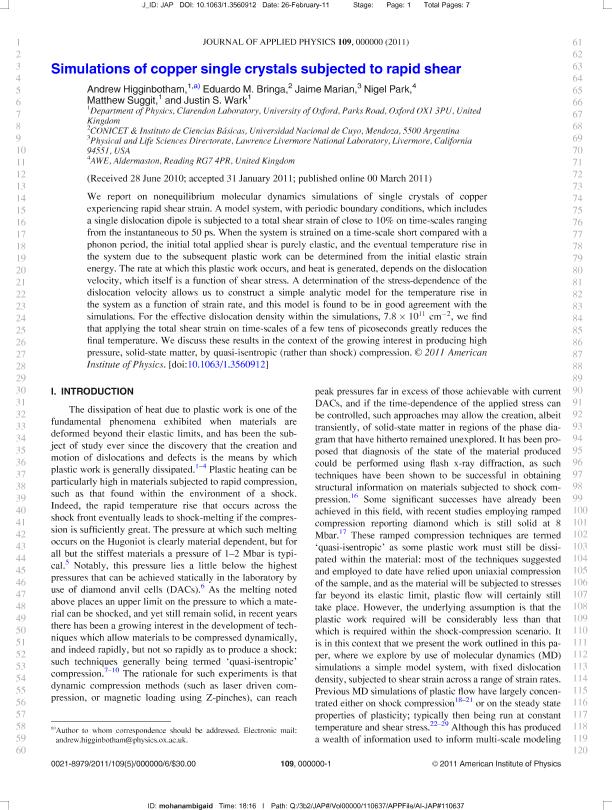Mostrar el registro sencillo del ítem
dc.contributor.author
Higginbotham, Andrew
dc.contributor.author
Bringa, Eduardo Marcial

dc.contributor.author
Marian, Jaime
dc.contributor.author
Park, Nigel
dc.contributor.author
Suggit, Matthew
dc.contributor.author
Wark, Justin S.
dc.date.available
2017-06-09T19:25:27Z
dc.date.issued
2011-03
dc.identifier.citation
Higginbotham, Andrew; Bringa, Eduardo Marcial; Marian, Jaime; Park, Nigel; Suggit, Matthew; et al.; Simulations of copper single crystals subjected to rapid shear; American Institute Of Physics; Journal Of Applied Physics; 109; 6; 3-2011; 63530-63536
dc.identifier.issn
0021-8979
dc.identifier.uri
http://hdl.handle.net/11336/17909
dc.description.abstract
We report on nonequilibrium molecular dynamics simulations of single crystals of copper experiencing rapid shear strain. A model system, with periodic boundary conditions, which includes a single dislocation dipole is subjected to a total shear strain of close to 10% on time-scales ranging from the instantaneous to 50 ps. When the system is strained on a time-scale short compared with a phonon period, the initial total applied shear is purely elastic, and the eventual temperature rise in the system due to the subsequent plastic work can be determined from the initial elastic strain energy. The rate at which this plastic work occurs, and heat is generated, depends on the dislocation velocity, which itself is a function of shear stress. A determination of the stress-dependence of the dislocation velocity allows us to construct a simple analytic model for the temperature rise in the system as a function of strain rate, and this model is found to be in good agreement with the simulations. For the effective dislocation density within the simulations, 7.8×1011cm−27.8×1011cm−2, we find that applying the total shear strain on time-scales of a few tens of picoseconds greatly reduces the final temperature. We discuss these results in the context of the growing interest in producing high pressure, solid-state matter, by quasi-isentropic (rather than shock) compression.
dc.format
application/pdf
dc.language.iso
eng
dc.publisher
American Institute Of Physics

dc.rights
info:eu-repo/semantics/openAccess
dc.rights.uri
https://creativecommons.org/licenses/by-nc-sa/2.5/ar/
dc.subject
Copper
dc.subject
Dislocation Dipoles
dc.subject.classification
Física de los Materiales Condensados

dc.subject.classification
Ciencias Físicas

dc.subject.classification
CIENCIAS NATURALES Y EXACTAS

dc.title
Simulations of copper single crystals subjected to rapid shear
dc.type
info:eu-repo/semantics/article
dc.type
info:ar-repo/semantics/artículo
dc.type
info:eu-repo/semantics/publishedVersion
dc.date.updated
2017-04-07T13:40:42Z
dc.journal.volume
109
dc.journal.number
6
dc.journal.pagination
63530-63536
dc.journal.pais
Estados Unidos

dc.journal.ciudad
Nueva York
dc.description.fil
Fil: Higginbotham, Andrew. University Of Oxford. Department Of Physics; Reino Unido
dc.description.fil
Fil: Bringa, Eduardo Marcial. Universidad Nacional de Cuyo. Facultad de Ciencias Exactas y Naturales; Argentina. Consejo Nacional de Investigaciones Científicas y Técnicas. Centro Científico Tecnológico Conicet - Mendoza; Argentina
dc.description.fil
Fil: Marian, Jaime. Lawrence Livermore National Laboratory. Physical and Life Sciences Directorate; Estados Unidos
dc.description.fil
Fil: Park, Nigel.
dc.description.fil
Fil: Suggit, Matthew. University Of Oxford. Department Of Physics; Reino Unido
dc.description.fil
Fil: Wark, Justin S.. University Of Oxford. Department Of Physics; Reino Unido
dc.journal.title
Journal Of Applied Physics

dc.relation.alternativeid
info:eu-repo/semantics/altIdentifier/url/http://aip.scitation.org/doi/10.1063/1.3560912
dc.relation.alternativeid
info:eu-repo/semantics/altIdentifier/doi/http://dx.doi.org/10.1063/1.3560912
Archivos asociados
